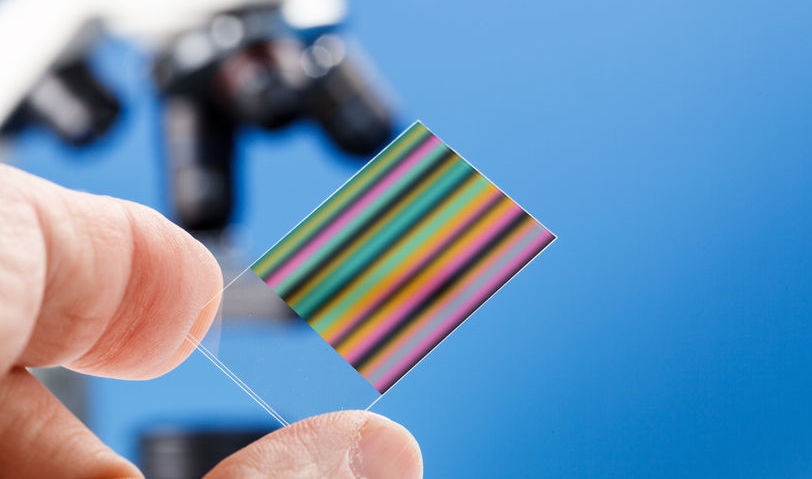
Chromatography is one of the most popular laboratory separation techniques. The name originated from the Greek words “chroma” (color) and “graphein” (to write). Chromatography was first used as a scientific method in 1903 by Mikhail Tsvet, a Russian scientist who applied it to separating colorful plant pigments. Chromatography is also one of the first chemical analysis techniques kids learn in school, as it can be demonstrated in a simplest format using paper and ink.
Chromatography Basics
Liquid chromatography involves several components: a stationary phase (sorbent), a mobile phase (solvent), and an analyte. The analyte is carried with the flow of mobile phase through the stationary phase and interacts with it. If the analyte is a mixture of the components, each component interacts with the stationary phase in a different manner and thus advances through a stationary phase at a different speed. The interaction with the stationary phase determines the retention of each component.
The stationary phase can be either packed in a column (column chromatography), or coated as a thin layer on a solid support (thin layer chromatography). Depending on the size of the column, chromatography can be performed on analytical scale (to analyze the mixture) or preparative scale (to purify a component from the mixture). Paper can be used as stationary phase as well (paper chromatography).
Several types of sorbents can be used as the stationary phase (also sometimes called chromatographic bed). The properties of the stationary phase, along with the properties of the moving mobile phase, determine the type of chromatographic separation. There are several possible types of interaction between the components of the analyte and the stationary phase, which can be used for separation, such as absorption, ion exchange, affinity etc., and all used in different types of chromatography.
Liquid Chromatography Methods
Let’s take a closer look at specific liquid chromatography methods.
The simplest of them is paper chromatography, in which paper serves as the stationary phase, water as the mobile phase, and a mix of water-soluble inks or pigments can be used as the analyte. In real life, if you cry over (or spill some tea on) an ink-written letter, the letters will become fuzzy and form a halo as the water spreads through the paper, driven by a capillary action. With enough liquid, you might see some color separation of the ink components.
One step up the professional ladder is thin layer chromatography (TLC), which commonly uses coats of alumina (aluminum oxide) and silica gel (silicone oxide) on a solid support as the stationary phase, and a solvent, or more often a mix of solvents, as the mobile phase. Selecting right solvent is an art. A chromatography tutorial from the University of Wisconsin-Madison (PDF) explains:
The eluting solvent should […] show a maximum of selectivity in its ability to dissolve or desorb the substances being separated. The fact that one substance is relatively soluble in a solvent can result in its being eluted faster than another substance. However, a more important property of the solvent is its ability to be itself adsorbed on the adsorbent. If the solvent is more strongly adsorbed than the substances being separated, it can take their place on the adsorbent and all the substances will flow together. If the solvent is less strongly adsorbed than any of the components of the mixture, its contribution to different rates of elution will be only through its difference in solvent power toward them.
The results of TLC are often visualized under ultraviolet light, offering a rapid and simple technique to analyze reaction products during chemical synthesis. The following video offers a short demonstration of analytical TLC and preparative column chromatography used to separate fluorescent dyes:
Chromatography Columns
Chromatography columns (hollow glass or metal tubes), packed with a stationary phase sorbent are used in multiple modern chromatography methods. In Size Exclusion/Gel Permeation Chromatography (GPC), gel sorbents with different pore sizes are used as the stationary phase. A popular technique to determine the molecular weight of polymers, gel permeation chromatography separates molecules according to their size, with smaller molecules entering the pores and eluting more slowly than the larger molecules.
In High Performance Liquid Chromatography (HPLC), now a favorite laboratory method, the drive for higher resolution and speed has resulted in smaller sorbent particles packed in narrow columns, with a solvent being pushed through the column by the application of pressure. Interestingly, HPLC originally meant High Pressure Liquid Chromatography. High pressure speeds up and improves the separation of different liquid chromatography systems — such as ion exchange chromatography or affinity chromatography — in addition to the previously described GPC, such as.
Chromatography is used to separate a variety of complex substances besides chemical compounds, such as wine, coffee, and tea, providing information about the unique components defining the taste and aroma, and helping us to control the quality of our food and drink. From the simplest dye separation to the most sophisticated biomolecules analysis, chromatography serves us well.
Image by luchschen/123RF.
Source: “Paper Chromatography (PDF),” by Hamid Rajabi, academia.edu.
Source: “Thin Layer Chromatography (PDF),” chem.wisc.edu.
Source: “Methods for Changing Peak Resolution in HPLC: Advantages and Limitations,” by Joseph J. DeStefano, William L. Johnson, Stephanie A. Schuster, and Joseph J. Kirkland, chromatographyonline.com, Volume 31, Issue 4, pp. s10-s18. Apr 1, 2013.
Source: “Sorbents for Chromatography,” VWR, us.vwr.com.
Video: “Chromatography,” by ChemToddler, YouTube.
